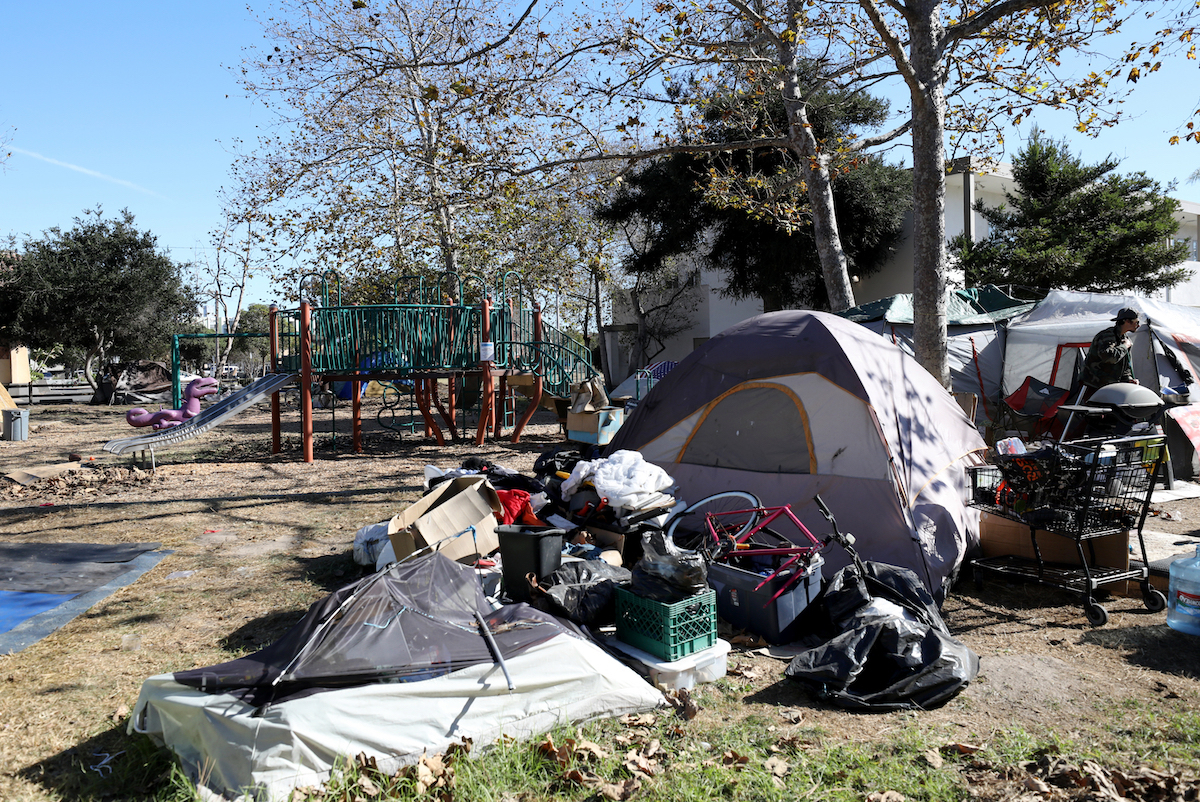Housing Prices Skyrocket, Homeless Camps Increase
County Supes Create ‘Encampment Response’ Czar

DUH ECONOMICS: Last week, I was alerted that a Leave It to Beaver–vintage ranch-style house on Palermo Road in Hidden Valley — a low-slung, quintessential middle-class neighborhood with the obligatory portable basketball hoop punctuating every cul-de-sac — went for $2.02 million.
If you think that’s a lot, it is. It’s also $271,000 over the asking price, a now-common phenomenon that’s still both astonishing and depressing and pretty much par for the course. Admittedly, it’s four bedrooms on a corner lot, and the architect, apparently overdosing on his kid’s stash of Ritalin, spared not a single bell or whistle on the inside. A masterpiece of showroom interior design. No matter where one sits, you don’t belong.
It’s that nice.
On my way to check it out, I passed dense thickets of feral vegetation intended to obscure the railroad tracks and freeway that run along Modoc Road. If I were homeless, I thought, maybe I could pitch a nice camp there. But then the powers that be would start calling it “an encampment.” The lingo intrigues me. The word “encampment” is infused with not-so-subliminal militaristic connotations that foment the notion we’re in a not-so-subliminal state of siege. Which, given the intrusive realities of poverty, drugs, and fire, we kind of are.
The number of such encampments, I learned at this Tuesday’s Board of Supervisors meeting, had increased by 34 percent from the year before. Maybe Hidden Valley homes fetching $2.02 million might be more than tangentially related. Sales like that will push the market even further out of reach for people whose calves are terminally cramped from standing on their tiptoes to keep their nostrils above the water level.
We’ve all heard about fire risks posed by these camps — I think I prefer that term — not to mention the mountains of garbage, untreated human sewage, stuff, and dirty needles. Crimes against people. Crimes against the environment. Calls for service.
It ain’t Huck Finn floating down the Mississippi.
This week, the supes voted to spend $1.5 million to hire an Encampment Response Coordinator at $160,000 a year to lead the county’s Encampment Response Team while executing its Encampment Response Protocol.
The hope is to “assess” 20 camps a year — for the next three years — and “to resolve” 15 of them, meaning that 60 percent of the residents will find alternate temporary housing, and of those, another 60 percent will find permanent supportive housing. This is happening because the county finds itself suddenly awash in state and federal funds to help people without housing. It’s also a case of flying the plane before you’ve attached the gas tank yet; it’s a three-year plan with a year’s worth of funding.
Beating the bushes to relocate our growing legion of urban campers will be 10 outreach workers — many formerly without homes themselves — working under the auspices of the increasingly ubiquitous nonprofit CityNet.
Sign Up to get Nick Welsh’s award-winning column, The Angry Poodle delivered straight to your inbox on Saturday mornings.
The $22 million question is: Where will all this alternate housing come from? Right now, if an urban camper agrees to come in from the wild, CityNet workers have no place to house them. We’re at capacity. That’s the bad news.
The good news, as Supervisor Gregg Hart relentlessly highlighted, is that capacity has dramatically expanded over the past six months. Translated, we now have 339 rapid response units, 46 permanent housing units, 215 long-term vouchers, and 137 temporary beds we didn’t have six months ago. That ain’t nothing. “We need to pause, recognize and celebrate,” Hart stressed.
Between April and June, 275 homeless people managed to move from the streets into something with a roof overhead and perhaps a door that could be locked. Of those, only 8 percent went back to their old ways. In Isla Vista, 27 of 41 former tent city occupants have since transitioned into some variant of the great indoors. None of this is remotely apparent to the naked eye or the casual observer.
The not-so-good news is that this is just a small fraction of all the housing that’s needed. Housing is ridiculously expensive to build, and providing the necessary services isn’t much cheaper. For every federal dollar now flooding the county coffers, the supes were told, there are demands and plans — from competing county agencies — on how they can spend $2.
Supervisor Das Williams kept hammering away on the need for more parking lots where people can park their cars at night and sleep safely. He kept asking for 14 lots, just 14 lots, imploring anyone with a spare parking lot lying around to step up and be counted. In the context of Tuesday’s conversation, Williams was ordering something decidedly not on the menu. But he had a point.
When you think of cost-effective, easy-to-build “housing” that people would actually live in — as opposed to shelters, which many people will absolutely shun — parking-lot housing is the low-hanging fruit. Yes, there is the NIMBY response, but that — like the parking lots themselves — can be managed.
New Beginnings has been doing precisely that for nearly 20 years.
Last week, the state legislature passed a couple of bills that will allow fourplexes to pop up on any parcel of land no matter what the zoning, with no affordability protections even mentioned. It’s a great bill if you subscribe to the magical thinking of trickle-up economics.
But in the meantime, the State of California could help by allowing New Beginnings to lease some of the many large parking lots it owns in Santa Barbara to provide four-wheeled housing. Right now, the state’s not returning New Beginnings’ calls.
What I noticed most at the Palermo Road house that just sold? No one was playing basketball.
Support the Santa Barbara Independent through a long-term or a single contribution.



